#Lyndall maccowan
Text
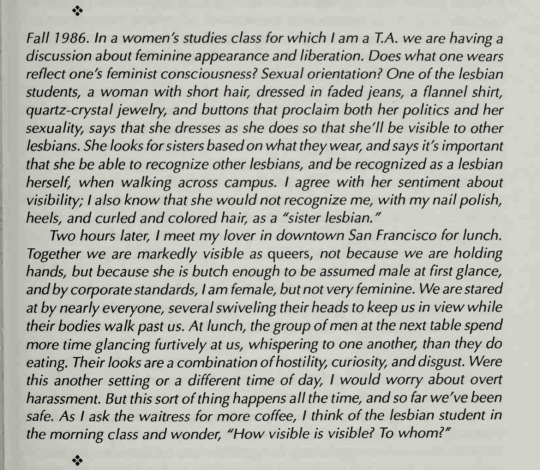
"Fall 1986. In a women's studies class for which I am a T.A., we are having a discussion about feminine appearance and liberation. Does what one wears reflect one's feminist consciousness? Sexual orientation? One of the lesbian students, a woman with short hair, dressed in faded jeans, a flannel shirt, quartz crystal jewlery, and buttons that proclaim both her politics and her sexuality, says that she dresses as she does so that she'll be visible to other lesbians. She looks for sisters based on what they wear, and says its important that she be able to recognize other lesbians, and be recognized as a lesbian herself, when walking across campus. I agree with her sentiment about visibility; I also know that she would not recognize me, with my nail polish, heels, and curled and colored hair, as a "sister lesbian."
Two hours later, I meet my lover in downtown San Francisco for lunch. Together we are markedly visible as queers, not because we are holding hands, but because she is butch enough to be assumed male at first glance, and by corporate standards, I am female, but not very feminine. We are stared at by nearly everyone, several swiveling their heads to keep us in view while their bodies walk past us. At lunch, the group of men at the next table spend more time glancing furtively at us, whispering to one another, than they do eating. Their looks are a combination of hostility, curiosity, and disgust. Were this another setting or a different time of day, I would worry about overt harassment. But this sort of thing happens all the time, and so far we've been safe. As I ask the waitress for more coffee, I think of the lesbian student in the morning class and wonder, "How visible is visible? To whom?"
-""Recollecting History, Renaming Lives: Femme Stigma and the feminist seventies and eighties" by Lyndall MacCowan, The Persistent Desire, (edited by Joan Nestle) (1992)
Edit: I sourced from the wrong essay originally. Apologies everyone! Fixed my citation.
#lesbian#lesbianism#lgbt#lgbtq+#lgbt history#lesbian history#butch#femme#butch femme#the persistent desire#queer history#queer#recs#writing#Lyndall MacCowan
1K notes
·
View notes
Text

Lyndall MacCowan, from The Persistent Desire: A Femme-Butch Reader edited by Joan Nestle
26 notes
·
View notes
Text

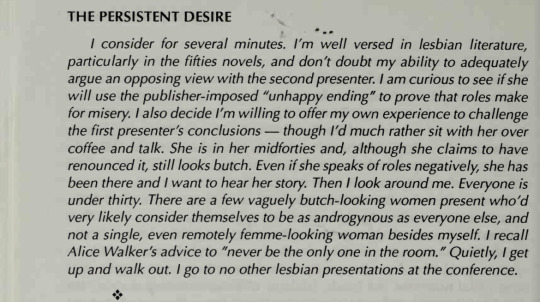
"The main justification for invalidating butch-femme is that its an imitation of heterosexual roles and, therefore, not a genuine lesbian model. One is tempted to react by saying "So what?" but the charge encompasses more than betrayal of an assumed fixed and "true" lesbian culture. Implicit in the accusation is the denial of cultural agency to lesbians, of the ability to shape and reshape symbols into new meanings of identification. Plagiarism, as the adage goes, is basic to all culture.
In the real of cultural identity, that some of the markers of a minority culture's boundaries originate in an oppressing culture is neither unusual nor particularly significant. For instance, in the United States certain kind of bead- and ribbon work are immediately recogniziable as specific to Native American cultures, wherein they serve artistic and ceremonial functions. Yet beads, trinkets, ribbons, and even certain "indian" blanket patterns were brought by Europeans, who traded them as cheap goods for land. No one argues that Indians out to give up beadwork or blanket weaving, thus ridding themselves of the oppressors symbols, because those things took on a radically different cultural meaning in the hands of Native Americans. Or consider Yiddish, one of the jewish languages. Although Yiddish is written in Hebrew characters and has its own idioms and nuances, its vocabulary is predominantly German. Those who speak German can understand Yiddish. Genocidal Germanic anti-Semitism dates back to at least the eleventh century. Yet East European Jews spoke "the oppressors language," developing in it a distinctive literary and theatrical tradition. Why is it so inconceivable that lesbians could take elements of heterosexual sex roles and remake them?
*
It is June 1987, and I am sitting in a workshop on "Lesbians and Gender Roles" at the annual National Women's Studies Conference. It is one of surprisingly few workshops on lesbian issues, particularly since, at a plenary session two mornings later, two thirds of the conference attendees will stand up as lesbians. Meanwhile, in this workshop the first speaker is spending half an hour on what she calls "Feminism 101," a description of heterosexual sex roles. Her point in doing this, she says, is to remind us of the origin of roles, "which are called butch and femme when lesbians engage in them." She tells us the purpose of her talk will be to prove, from her own experience, that "these roles are not fulfilling" for lesbians. She tells us that the second speaker will use lesbian novels from the 1950s to demonstrate the same thesis. And, indeed, the second speaker has a small stack of 1950s "pulp paperbacks" with her, many of them the titles that, when I discovered them in the mind-1970s, resonated for me in a way that the feminist books published by Daughters and Diana Press did not.
I consider for several minutes. I'm well versed in lesbian literature, particularly in the fifties novels, and don't doubt my ability to adequately argue an opposing view with the second presenter. I am curious to see if she will use the publisher-imposed "unhappy ending" to prove that roles make for misery. I also decide I'm willing to offer my own experience to challenge the first presenters conclusions- though I'd much rather sit with her over coffee and talk. She is in her midforties and, although she claims to have renounced it, still looks butch. Even if she speaks of roles negatively, she has been there and I want to hear her story. Then I look around me. Everyone is under thirty. There are a few vaguely butch-looking women present who'd very likely consider themselves to be as androgynous as everyone else, and not a single, even remotely femme-looking women besides myself. I recall Alice Walker's advice to "never be the only one in the room." Quietly, I get up and walk out. I go to no other lesbian presentations at the conference."
“Recollecting History, Renaming Lives: Femme Stigma and the feminist seventies and eighties" by Lyndall MacCowan, The Persistent Desire, (edited by Joan Nestle) (1992)
#the persistent desire#Lyndall MacCowan#Joan nestle#lesbian#lesbianism#butch and femme#butchfemme#butch and femme history#butch lesbian#femme lesbian#butch history#femme history#lesbian history#lesbian culture#lesbian feminism#lesbian feminist history#lgbt history#queer history
90 notes
·
View notes
Text

"Butch and femme are lesbian specific genders, two of potentially many ways to be both a lesbian and a woman. They are unliberated only in the sense that they need liberating from the assumption, made by heterosexuals and lesbian-feminists alike, that they are an imitation of heterosexuality, a clinging to vestiges of heterosexual femininity or an attempt to masquerade as a man. As Judy Grahn has said about being butch:
Our point was not to be men; our point was to be butch and get away with it. We always kept something back: a high-pitched voice, a slant of the head, or a limpness of hand gestures, something that was clearly labeled female. I believe our statement was "here is another way of being a woman," not "Here is a woman trying to be taken for a man.""
"Re-Collecting History, renaming lives: Femme Stigma and the Feminist Seventies and Eighties", Lyndall MacCowan, The Persistent Desire, (Edited by Joan Nestle) (1992)
#lesbian#butch#femme#butch femme#lesbian history#lgbt#lgbtq+#lgbt history#the persistent desire#recs#writing#lesbianism#Lyndall MacCowan
173 notes
·
View notes
Text

"Gender systems are a cultural universal. Every society organizes its members into two or more genders. Gender expresses and signals two things: what tasks an individual performs (division of labor) and with whom (what other gender) one has sex. However, the degree of distinction between genders, the rigidity with which they are applied, the particular characteristics given to each, and the number of genders that are recognized vary enormously. It's generally true that where women are oppressed, homosexuality, especially lesbianism, is also repressed as a gender or identity, though it may be accepted as a behavior. What is not true is that a gender system always implies sexism or homophobia.
There's no question that sex-role conditioning in our male dominated society is one of the primary means by which women's oppression is perpetrated. Gender systems (which sex roles express), however are not intrinsically oppressive. What is oppressive in our society is the linking of biological sex (female or male) to gender identity (woman or man), gender or sex role (feminine or masculine), sexual object choice (opposite), and sexual identity (heterosexual). Barbara Ponse calls these correlations "the principle of consistency." It is the system, and the denial of any other construction of gender, on which sexism is founded. The problem is the correlations, not the specific components.
What's oppressive about gender, defined sex roles, in our society is that they are limited to two, rigidely correlated with biological sex, and obsolete, in a complex industrial society, as an expression of who does what work. The sex-role oppression that feminism means to criticize is rooted in the social restriction, the male=aggressive=breadwinner and female=passive=housewife model of heterosexuality; traditional heterosexual sex roles are but symptoms of that restriction. Gender per se is not the problem, and I think it is impossible, as well as pointless, to try to rid ourselves of it. Certainly, lesbian-feminism has not been able to: it's "androgynous" norm is itself a gender, serving precisely to signal that one is a woman who sleeps with women. Butch and femme are also genders, reflecting a complementarity of personas within a woman-to-woman relationship."
"Recollecting History, Renaming Lives: Femme Stigma and the feminist seventies and eighties" by Lyndall MacCowan, The Persistent Desire, (edited by Joan Nestle) (1992)
#lesbian#lesbianism#lesbian history#the persistent desire#lgbt history#lgbt+ history#lgbtq+ history#writing#recs#femme#butch#femme butch#gender roles#gender#Lyndall MacCowan
97 notes
·
View notes
Text


"What does it mean to be a lesbian?
To be a lesbian means to be queer. It means to fall in love each year with at least one girl in my classroom, as well as with the bus driver, the baby-sitter, the camp counselor, and my fourth grade teacher. It means to spend the night, at the age of nine or ten, at another girl's house and to touch her anywhere I can get away with. It means knowing I'm a freak. It means, at thirteen, spending all my time at a teacher's home and, when my mother decides this woman is a cover for a boy, being thrown out of the house. It means knowing that I am not a woman. It means pushing away a friend who's crying because someone has called her a lesbian. It means knowing I am alone. it means falling in love with girls and, at the same time, despising their femininity, their obsession with makeup and boys, their lack of strength or brains. It means knowing that both the kind of woman I want and the kind of woman I am don't exist, do not have names.
To be a lesbian means to come out in high school and be greeted with silence. It means to go to San Francisco and wind up living on the streets. It means to go hungry and to sleep in doorways, or at the DOB office, or on the concrete floor of a warehouse. Or to all all night through the city.
It means being in the emergency room of S.F. General one late night and seeing a woman rolled in who's been knifed for being a lesbian, and may not live. It means knowing other lesbians who one day put a gun to their heads and pull the trigger. It means claiming lesbianism as a sexual desire that is unescapable sledgehammer pounding in my blood. it means running to the nearest gay bar, the military, the convent, the gay rights movement, or the closet. It means acknowledging that being a lesbian, if it does not someday make me kill myself, is something that can get me killed.
To be a lesbian is to be sexual, even though women aren't supposed to be sexual, and to experience that sexualness with women."
"Recollecting History, Renaming Lives: Femme Stigma and the feminist seventies and eighties" by Lyndall MacCowan, The Persistent Desire, (edited by Joan Nestle) (1992)
#lesbian#lesbianism#lesbian history#the persistent desire#butch femme#lgbt#lgbtq+#lgbt history#writing#recs#Lyndall MacCowan
88 notes
·
View notes
Text
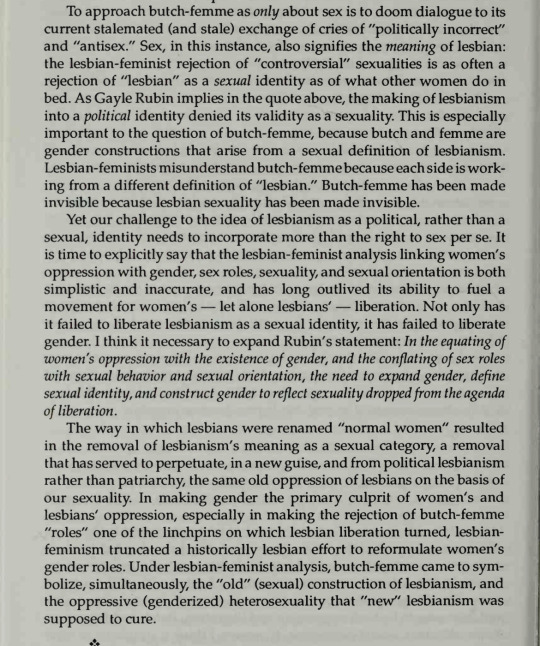
"To approach butch-femme as only about sex is to doom dialogue to it's current stalemated (and stale) exchange of cries of "politically incorrect" and "antisex". Sex, in this instance, also signifies the meaning of lesbian: The lesbian-feminist rejection of controversial sexualities is as often a rejection of "lesbian" as a sexual identity as of what other women do in bed. As Gayle Rubin implies in the quote above, the making of lesbianism into a political identity denied its validity as a sexuality. This is especially important to the question of butch-femme, because butch and femme are gender constructions that arise from a sexual definition of lesbianism. Lesbian-feminists misunderstand butch-femme because each side is working from a different definition of "lesbian". Butch-femme has been made invisible because lesbian sexuality has been made invisible. Yet our challenge to the idea of lesbianism as a political, rather than sexual, identity needs to incorporate more than the right to sex per se. It is time to explicitly say that the lesbian-feminist analysis linking women's oppression with gender, sex roles, sexuality, and sexual orientation is both simplistic and inaccurate, and has long outlived its ability to fuel a movement for women's- let alone lesbians- liberation. Not only has it failed to liberate lesbianism as a sexual identity, it has failed to liberate gender. I think it necessary to expand Rubin's statement: In the equating of women's oppression with the existence of gender, and the conflating of sex roles with sexual behavior and sexual orientation, the need to expand gender, define sexual identity, and construct gender to reflect sexuality dropped from the agenda of liberation.
The way in which lesbians were renamed "normal women" resulted in the removal of lesbianism's meaning as a sexual category, a removal that has served to perpetuate, in a new guise, and from political lesbianism rather than patriarchy, the same old oppression of lesbians on the basis of our sexuality. In making gender the primary culprit of women's and lesbian's oppression, especially in making the rejection of butch-femme "role" one of the linchpins on which lesbian liberation turned, lesbian-feminism truncated a historically lesbian effort to reformulate women's gender roles. Under lesbian-feminist analysis, butch-femme came to symbolize, simultaneously, the "Old" (sexual) construction of lesbianism, and the oppressive (genderized) heterosexuality that "new" lesbianism was supposed to cure."
"Recollecting History, Renaming Lives: Femme Stigma and the feminist seventies and eighties" by Lyndall MacCowan, The Persistent Desire, (edited by Joan Nestle) (1992)
#lesbian#lesbianism#lesbian history#lgbt history#gay history#lgbtq+ history#the persistent desire#butch femme#butch lesbian#femme lesbian#feminism#lesbian feminism#butch#femme#Lyndall MacCowan
59 notes
·
View notes
Text
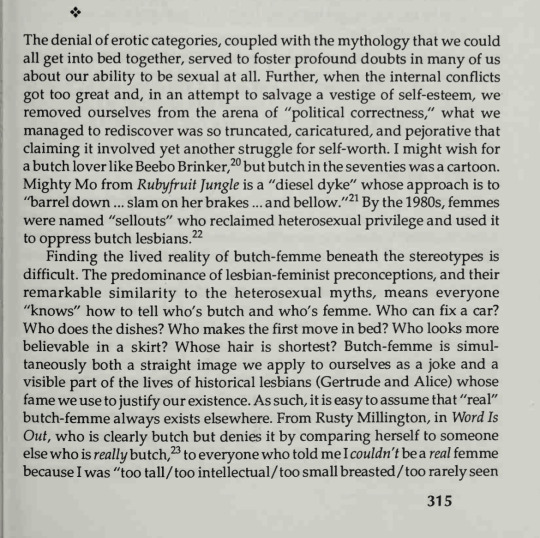


"The denial of erotic categories, coupled with the mythology that we could all get into bed together, served to foster profound doubts in many of us about our ability to be sexual at all. Further, when the internal conflicts got too great and, in an attempt to salvage a vestige of self-esteem, we removed ourselves from the arena of “political correctness,” what we managed to rediscover was so truncated, caricatured, and pejorative that claiming it involved yet another struggle for self-worth. I might wish for a butch lover like Beebo Brinker, but butch in the seventies was a cartoon. Mighty Mo from Rubyfruit Jungle is a “diesel dyke” whose approach is to “barrel down… slam on her breaks… and bellow.” By the 1980s, femmes were named “sellouts” who reclaimed heterosexual privilege and used it to oppress butch lesbians.
Finding the lived reality of butch-femme beneath the stereotypes is difficult. The predominance of lesbian-feminist preconceptions, and their remarkable similarity to the heterosexual myths, means everyone “knows” how to tell who’s butch and who’s femme. Who can fix a car? Who does the dishes? Who makes the first move in bed? Who looks more believable in a skirt? Whose hair is shortest? Butch-femme is a simultaneously both a straight image we apply to ourselves as a joke and a visible part of the lives of historical lesbians (Gertrude and Alice) whose fame we used to justify our existence. As such, it is easy to assume that “real” butch-femme always exists elsewhere. From Rusty Millington, in Word is Out, who is clearly butch but denies it by comparing herself to someone else who is really butch, to everyone who told me I couldn’t be a real femme because I was “too tall/too intellectual/too small breasted/too rarely seen in a skirt,” the message is that one might get away with being “into roles” as long as one doesn’t call them that. I am reminded, ironically, of Joana Russ’s litany of the requirements for “real lesbians,” and her conclusion: “There are no real lesbians; real lesbians have horns.” The speed with which women who reclaimed the words lesbian and dyke say they “can’t relate to labels” never fails to amaze me.
In the past, butch-femme appears to have been an admixture of heterosexual expectations and genuine challenges to the traditional construction of female gender; the shape it takes in the 1990s, one hopes, might break free of the former if lesbian-feminists would stop naming us an imitation. What is most difficult in claiming butch-femme in a “postliberation” era, however, is untangling both the homophobia that defined “real lesbian” as butch and butch-femme’s association, like that Del and Phyl make, with only a heterosexual portrait. Sally Gearhart remembers:
I think the pressure was from society, which made me feel that, if I was not a woman in the sense that the society said a woman should be, then I must be a butch. I don’t think I understood that there could be femme lesbians. I didn’t think I understood that there could be femme lesbians. I didn’t want to do the things ordinary women did, so therefore I must be like a man, and therefore, I think I dressed and acted more butch than I probably was.
Under this equation, femme is not quite a “real lesbian.” Pat Bond recalls:
There was a lot of pressure to look butch if you were [butch]. And, of course, you wanted to, ‘cause you wanted to be identified as a dyke. I was never too good at it. I looked really funny trying to look like a man. Men’s pants look funny because I’m very short waisted and big busted. Trying to wear the short haircut with sideburns shaved over the ears, I looked like the missing link.
The standard of lesbian-feminist androgyny are equally intolerant. I’ve heard from more than one younger lesbian reluctance to claim the name “lesbian” because the movement conveys “it means having to give up being a girl” because the movement conveys “it means having to give up being a girl.” For a long time, I thought I couldn’t be femme because I had never been straight. Lesbian-feminism seems determined to portray butch-femme as rigid, even though butch and femme characteristics can be interchangeable, subtle, and allow for more variation than do heterosexual sex roles. Degrees of butchness and femmeness- stone butch, butchy femme, femmy butch, ki-ki- are named points on a spectrum that is shortchanged when portrayed as masculine-feminine extremes. It is difficult to imagine heterosexual patriarchy allowing women to experiment with and choose sexual roles or no role at all. Yet, it is from feminists that I still hear that I can’t wear a skirt, whereas my butch lover Jo never thought knowing how to rebuild an engine made me less femme.
As an issue, butch-femme is fraught with ambivalence and denial. When Jo Ann Loulan asked lesbian audiences around the United States if they had ever rated themselves or been rated by others on a butch-femme scale, 95% acknowledged they had. Yet the same percentage also affirmed that they “did not consider butch-femme to be an important concept in their lives.” Loulan points that this is a statistical anomaly; rarely does a group insist that a universal experience is universally unimportant. In a separate but related survey, Loulan found that one-third of her respondents identified themselves as either butch or femme, but that fully three-quarters of those who did so claimed not to demonstrate that identity in obvious ways within the lesbian community. If Loulan’s data is valid, a substantial proportion of one-third of the community is “in the closet” about a butch-femme identity."
"Recollecting History, Renaming Lives: Femme Stigma and the feminist seventies and eighties" by Lyndall MacCowan, The Persistent Desire, (edited by Joan Nestle) (1992)
#the persistent desire#Lyndall maccowan#Joan nestle#lesbian#lesbianism#butch and femme#butch lesbian#femme lesbian#butch#femme#lgbt+#lgbtq+#lesbian writing#lesbian history#lgbtq+ history#lgbtq+ writing#writing#history#long post
35 notes
·
View notes
Text
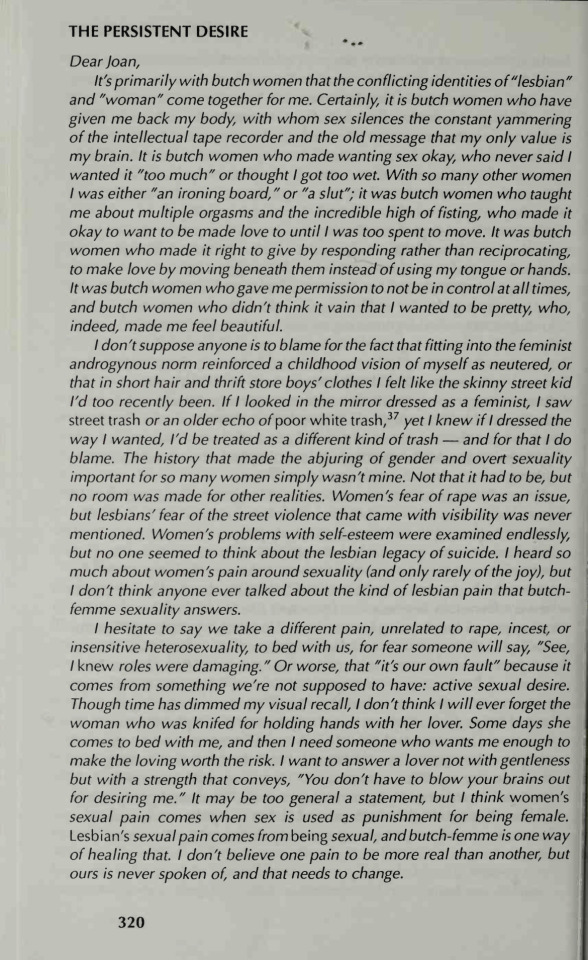
"Dear Joan,
It's primarily with butch women that the conflicting identities of "lesbian" and "woman" come together for me. Certainly, it is butch women who have given me back my body, with whom sex silences the constant yammering of the intellectual tape recorder and the old message that my only value is my brain. It is butch women who made wanting sex okay, who never said I wanted it "too much" or thought I got too wet. With so many other women I was either "an ironing board", or "a slut"; it was butch women who taught me about multiple orgasms and the incredible high of fisting, who made it ok to want to be made love to until I was too spent to move. it was butch women who made it right to give by responding rather than reciprocating, to make love by moving beneath them instead of using my tongue or hands. It was butch women who gave me permission to not be in control at all times, and butch women who didn't think it vain that I wanted to be pretty, who, indeed, made me feel beautiful.
I don't suppose anyone is to blame for the fact that fitting into the feminist androgynous norm reinforced a childhood vision of myself as neutered, or that in short hair and thrift store boy's clothes I felt like the skinny street kid I'd too recently been. If I looked in the mirror dressed as a feminist, I saw street trash or an older echo of poor white trash, yet I knew if I dressed the way I wanted, I'd be treated as a different kind of trash- and for that I do blame. The history that made the abjuring of gender and overt sexuality important for so many women simply wasn't mine. Not that it had to be, but no room was made for other realities. Women's fear of rape was an issue, but lesbians' fear of the street violence that came with visibility was never mentioned. Women's problems with self esteem were examined endlessly, but no one seemed to think about the lesbian legacy of suicide. I heard so much about women's pain around sexuality (and only rarely of the joy), but I don't think anyone ever talked about the kind of pain that butch-femme sexuality answers.
I hesitate to say we take a different pain, unrelated to rape, incest, or insensitive heterosexuality, to bed with us, for fear someone will say, "See I knew roles were damaging." Or worse, that "its our own fault" because it comes from something we're not supposed to have: active sexual desire. Though time has dimmed my visual recall, I don't think I will ever forget the woman who was knifed for holding hands with her lover. Some days she comes to bed with me, and then I need someone who wants me enough to make the loving worth the risk. I want to answer a lover not with gentleness but with a strength that conveys, "You don't have to blow your brains out for desiring me." It may be too general a statement, but I think women's sexual pain comes when sex is used as a punishment for being female. Lesbian's sexual pain comes from being sexual, and butch-femme is one way of healign that. I don't believe one pain to be more real than another, but ours is never spoken of, and that needs to change."
"Recollecting History, Renaming Lives: Femme Stigma and the feminist seventies and eighties" by Lyndall MacCowan, The Persistent Desire, (edited by Joan Nestle) (1992)
#lesbian#lesbianism#lesbian history#the persistent desire#butch femme#butch lesbian#femme#butch#femme lesbian#lgbt history#lgbtq+ history#writing#Lyndall MacCowan
29 notes
·
View notes